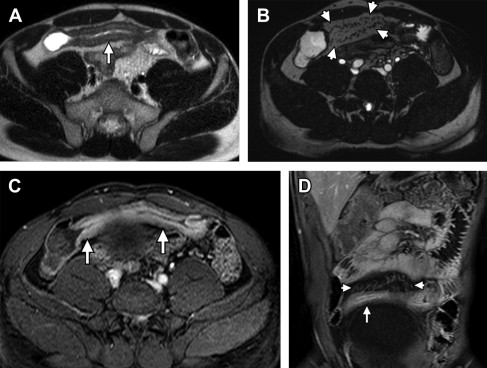MR enterography has an established role in evaluating patients with Crohn disease providing essential complementary information to clinical assessment, and as an indispensible adjunct to clinical tools such as colonoscopy. MR enterography examinations can establish the diagnosis of Crohn disease, evaluate disease activity and complications, and assess treatment response, thus providing support for clinical decision-making. Currently, MR imaging findings are highly predictive of tissue inflammation and can be used clinically to guide clinical care.
Key points
- •
MR enterography has an established role in evaluating patients with Crohn disease providing essential complementary information to clinical assessment, and as an indispensible adjunct to clinical tools such as colonoscopy.
- •
MR enterography examinations can establish the diagnosis of Crohn disease, evaluate disease activity and complications, and assess treatment response, thus providing support for clinical decision-making.
- •
Currently, MR imaging findings are highly predictive of tissue inflammation and can be used clinically to guide clinical care. However, imaging so far has a limited role in accurately identifying stricturing disease.
- •
Potential exists for MR imaging sequences such as diffusion-weighted imaging and magnetization transfer to assess noninvasively both tissue inflammation and fibrosis and become a highly valuable biomarker of disease progression through monitoring the course of the disease and response to treatment.
Introduction
Over the past decade, radiologic imaging has come to play an important role in the diagnosis and management of Crohn disease (CD), an inflammatory disease of the gastrointestinal tract. This role in the diagnosis and management was brought about by advances in the radiologic imaging technology and better understanding of the disease process, its natural history, and long-term complications. In addition, the emerging emphasis on mucosal healing as an endpoint in clinical trials, and the potential of potent biologic therapies to alter the natural history of CD, have spurred interest in more complete evaluation of the small intestine. In clinical trials and in clinical practice, optical endoscopy techniques (colonoscopy, deep small bowel enteroscopy, and capsule endoscopy) have been the primary tools used for detecting mucosal inflammation. These techniques allow direct visualization of the intestinal mucosa and the acquisition of mucosal biopsies for histologic evaluation. However, routine colonoscopy has limited ability to access diseased small bowel segments (proximal small bowel disease or proximal to a stenosed ileocecal valve). Furthermore, colonoscopy has drawbacks related to procedural invasiveness including relatively poor patient acceptance, patient discomfort, the need for a bowel preparation, and the risk of bowel perforation. Other diagnostic imaging examinations that are available for the evaluation of CD, including ultrasound, fluoroscopy, computed tomography (CT), magnetic resonance (MR) imaging, and positron emission tomography with CT (PET-CT), have strengths and weaknesses with respect to small intestinal imaging. One particular imaging modality, MR imaging examination, has demonstrated a marked increase in utilization with wider acceptance by both gastroenterologists and radiologists. One of the major advantages driving the increased utilization of MR imaging is the lack of ionizing radiation, an important consideration in young CD patients facing a life-long disease that may require relatively frequent or repeated radiographic examinations. Utilization of MR imaging spares patients the risk of cumulative radiation dose from multiple CT scans. Another advantage of MR imaging is the potential for tissue characterization compared with the other imaging techniques given the ability of MR imaging to assess different biophysical characteristics of the imaged tissues (eg, T1-weighting, T2-weighting, T2*-weighting) as well as more recently investigated tissue contrast based on diffusion (diffusion-weighted imaging, DWI) and magnetization transfer (MT). The MR imaging examination that is optimized for bowel evaluation is named MR enterography (MRE). In this technique, nonabsorbable oral contrast agent is used to improve bowel distension (eg, polyethylene glycol, mannitol, methylcellulose, or VoLumen [Bracco Diagnostics Inc, Princeton, NJ, USA]) and allow better evaluation of the bowel wall and lumen. The MRE examination allows evaluation of most of the gastrointestinal tract in the abdominal and pelvic cavity (including the stomach, duodenum, small and large bowel down to the anal region) in a single examination, in addition to the evaluation of the extra-enteric abdominal organs.
Introduction
Over the past decade, radiologic imaging has come to play an important role in the diagnosis and management of Crohn disease (CD), an inflammatory disease of the gastrointestinal tract. This role in the diagnosis and management was brought about by advances in the radiologic imaging technology and better understanding of the disease process, its natural history, and long-term complications. In addition, the emerging emphasis on mucosal healing as an endpoint in clinical trials, and the potential of potent biologic therapies to alter the natural history of CD, have spurred interest in more complete evaluation of the small intestine. In clinical trials and in clinical practice, optical endoscopy techniques (colonoscopy, deep small bowel enteroscopy, and capsule endoscopy) have been the primary tools used for detecting mucosal inflammation. These techniques allow direct visualization of the intestinal mucosa and the acquisition of mucosal biopsies for histologic evaluation. However, routine colonoscopy has limited ability to access diseased small bowel segments (proximal small bowel disease or proximal to a stenosed ileocecal valve). Furthermore, colonoscopy has drawbacks related to procedural invasiveness including relatively poor patient acceptance, patient discomfort, the need for a bowel preparation, and the risk of bowel perforation. Other diagnostic imaging examinations that are available for the evaluation of CD, including ultrasound, fluoroscopy, computed tomography (CT), magnetic resonance (MR) imaging, and positron emission tomography with CT (PET-CT), have strengths and weaknesses with respect to small intestinal imaging. One particular imaging modality, MR imaging examination, has demonstrated a marked increase in utilization with wider acceptance by both gastroenterologists and radiologists. One of the major advantages driving the increased utilization of MR imaging is the lack of ionizing radiation, an important consideration in young CD patients facing a life-long disease that may require relatively frequent or repeated radiographic examinations. Utilization of MR imaging spares patients the risk of cumulative radiation dose from multiple CT scans. Another advantage of MR imaging is the potential for tissue characterization compared with the other imaging techniques given the ability of MR imaging to assess different biophysical characteristics of the imaged tissues (eg, T1-weighting, T2-weighting, T2*-weighting) as well as more recently investigated tissue contrast based on diffusion (diffusion-weighted imaging, DWI) and magnetization transfer (MT). The MR imaging examination that is optimized for bowel evaluation is named MR enterography (MRE). In this technique, nonabsorbable oral contrast agent is used to improve bowel distension (eg, polyethylene glycol, mannitol, methylcellulose, or VoLumen [Bracco Diagnostics Inc, Princeton, NJ, USA]) and allow better evaluation of the bowel wall and lumen. The MRE examination allows evaluation of most of the gastrointestinal tract in the abdominal and pelvic cavity (including the stomach, duodenum, small and large bowel down to the anal region) in a single examination, in addition to the evaluation of the extra-enteric abdominal organs.
CD classification
CD is a chronic transmural inflammatory disorder that can affect any part of the gastrointestinal tract, most commonly the ileocecal region. CD and ulcerative colitis are the 2 major diseases under the umbrella term of “inflammatory bowel disease” (IBD). The inflammatory process in CD patients is thought to arise from altered gut mucosal immunity leading to cytokine overproduction and increased bowel wall leukocyte infiltration. Luminal bacteria and the microbiota likely play a major role in the pathogenesis of IBD. Clinically, the disease is classified into 3 categories as determined by the disease manifestations and symptoms, disease localization in the gastrointestinal tract, and the presence of complications such as strictures or penetrating disease (sinus tract, fistula, or abscess). In the Vienna classification, disease behavior is separated into 3 prognostic relevant entities including nonstricturing and nonpenetrating (B1), stricturing (B2), and penetrating (B3) disease. This classification system was later modified in the Montreal classification by adding perianal penetrating disease, because perianal fistulas and abscesses have a different prognosis and outcome than intra-abdominal penetrating forms of CD. Patients may remain in the same disease category throughout their life or show disease progression usually from inflammatory to stricturing and penetrating disease. Although these classifications systems were designed originally to classify CD patients for clinical studies, the different subtypes of disease manifestation can be also used to determine treatment decisions. Inflammatory phenotype is treated medically most of the times. The stricturing phenotype requires intervention with mechanical treatments, such as balloon dilatation, stricturoplasty, or resection, in many cases. The penetrating phenotype would eventually require surgical treatment in most cases. MRE can offer similar disease phenotype characterization based on characteristic imaging findings and can differentiate penetrating and stricturing disease from nonstricturing/nonpenetrating (or inflammatory) disease. Accurate disease classification and detection of associated complications on radiologic evaluation are important for guiding the therapeutic decision-making process and has been shown to be better than clinical assessment alone. Based on radiologic evaluation and the presence of characteristic findings, bowel involvement can be characterized as active inflammatory, fibrostenotic, or fistulizing/perforating disease, which parallels the clinical classification system. Additional suggested radiologic group is the reparative/regenerative subset, which corresponds to lack of significant disease activity with the presence of mucosal atrophy and regenerative polyps. A recent study by Schill and colleagues correlated the behavior assessment performed by a radiologist based on MR imaging findings with the surgeons’ clinical assessment based on surgical exploration of patients with CD and found a very high interobserver agreement of 0.937 with identical assessment in 97% of all patients. In a recently published meta-analysis, MR had a per-patient sensitivity of up to 93% in diagnosing IBD, as such MRE examinations are increasingly being used by the gastroenterologists and surgeons as a primary or follow-up imaging modality for assessing disease location and behavior, to decide on further therapeutic options, such as bowel resection, endoscopic or pharmaceutical interventions.
Imaging findings
MRE is used to evaluate the entire spectrum of CD manifestations and provide assessment of the disease extent and activity. CD evaluation includes both the bowel and the surrounding tissues, as the disease usually starts in the mucosal lining and extends across the bowel wall, potentially involving the peri-enteric structures (mesenteric fat or adjacent organs). Findings related to the bowel seen in active inflammation, includes mucosal ulcerations, a stratified pattern of mural enhancement, and bowel wall thickening (due to edema and infiltration with inflammatory cells) ( Figs. 1 and 2 ). Imaging findings described in fibrostenosing disease include bowel wall thickening (due to deposition of collagen), more homogeneous mural enhancement, and luminal narrowing with associated prestenotic bowel dilatation ( Fig. 3 ). It is important to note that imaging findings in fibrostenosing disease rely more on lack of findings typically associated with active inflammation rather than direct visualization of fibrotic tissues. Pseudopolyps develop as a consequence of healing, indicate prior severe inflammation, and appear as polypoid lesions seen along the mucosal lining of the bowel. Extension of the inflammation across the serosal lining of the bowel, corresponding to penetrating disease, can lead to formation of a blind ending sinus tract initially, and if there is communication with another structure, a fistula tract develops (eg, enteroenteric, enterocolic, enterocutaneous, enterovesicular) ( Fig. 4 ). Penetrating disease can also lead to the formation of adjacent abscess cavity (interloop or perianal) depending on the location of the diseased bowel segment ( Fig. 5 ). Additional findings that can be seen in the tissues surrounding the affected bowel segments include reactive enlargement of the mesenteric or pericolic lymph nodes, increased haziness of the mesenteric or per-colic fat due to infiltration by fluid and edema, and engorgement of the mesenteric vessels supplying the affected segment secondary to hyperemia. Fibrofatty proliferation surrounding the affected bowel segments is not specific to disease activity and is usually seen in longstanding disease. Common extraenteric findings include cholelithiasis, urinary tract calculi, and sacro-ileitis, which can also be assessed on MRE.


Stay updated, free articles. Join our Telegram channel

Full access? Get Clinical Tree





